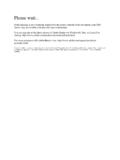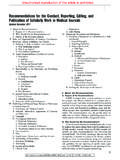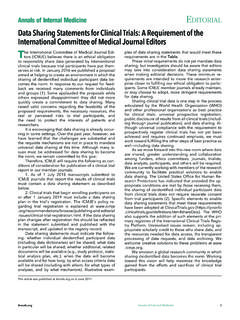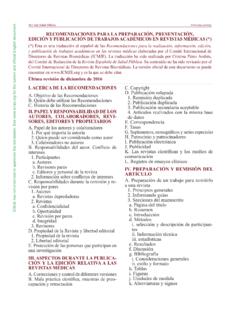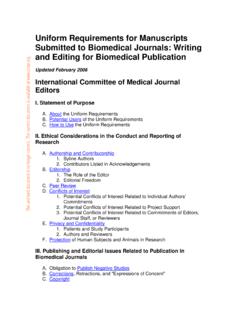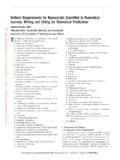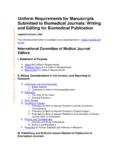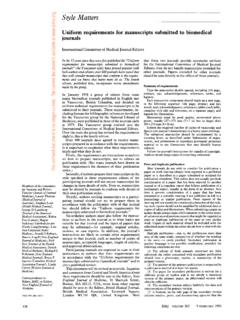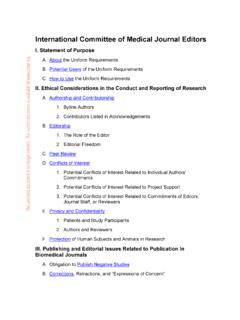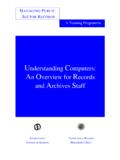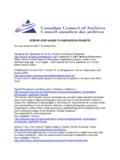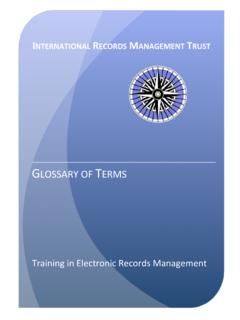Transcription of 012397 Uniform Requirements for Manuscripts …
1 SPECIAL REPORTV olume 336 Number 4 309 Special ReportUNIFORM Requirements FOR Manuscripts submitted TO BIOMEDICAL JOURNALSINTERNATIONAL COMMITTEE OF MEDICAL JOURNAL EDITORS**The members of the committee are Linda Clever (Western Journal ofMedicine), Lois Ann Colaianni (Index Medicus), Frank Davidoff (Annals ofInternal Medicine), Richard Horton (Lancet), Jerome P. Kassirer and Mar-cia Angell (New England Journal of Medicine), George D. Lundberg andRichard Glass (Journal of the American Medical Association), MagneNylenna (Tidsskrift for den Norske Laegeforening), Richard G. Robinson(New Zealand Medical Journal), Richard Smith (British Medical Journal),Bruce P.
2 Squires (Canadian Medical Association Journal), and Martin VanDer Weyden (Medical Journal of Australia). 1997, Massachusetts Medical Society. SMALL group of editors of general med-ical journals met informally in Vancouver,British Columbia, in 1978 to establishguidelines for the format of manuscriptssubmitted to their journals. The group becameknown as the Vancouver Group. Its Requirements formanuscripts, including formats for bibliographic ref-erences developed by the National Library of Med-icine, were first published in 1979. The VancouverGroup expanded and evolved into the InternationalCommittee of Medical Journal Editors (ICMJE),which meets annually; gradually it has broadened committee has produced five editions of the Uniform Requirements for Manuscripts Submittedto Biomedical Journals.
3 Over the years, issues havearisen that go beyond manuscript preparation. Someof these issues are now covered in the Uniform Re-quirements ; others are addressed in separate state-ments. Each statement has been published in a sci-entific fifth edition (1997) is an effort to reorganizeand reword the fourth edition to increase clarity andaddress concerns about rights, privacy, descriptionsof methods, and other matters. The total content of Uniform Requirements for Manuscripts Submittedto Biomedical Journals may be reproduced for ed-ucational, not-for-profit purposes without regard forcopyright; the committee encourages distribution ofthe that agree to use the Uniform Require-ments (over 500 do so) are asked to cite the 1997document in their instructions to and comments should be sent to Kath-leen Case at the ICMJE secretariat office, Annals ofInternal Medicine, American College of Physicians,Independence Mall W.
4 , Sixth St. at Race, Phila-delphia, PA 19106-1572, United States (Phone:215-351-2661; Fax: 215-351-2644; e-mail: represented on the ICMJE in 1996were: the Annals of Internal Medicine, the BritishMedical Journal, the Canadian Medical AssociationJournal, the Journal of the American Medical Associ-ation, the Lancet, the Medical Journal of Australia,the New England Journal of Medicine, the New Zea-Aland Medical Journal, the Tidsskrift for den NorskeLaegeforening, the Western Journal of Medicine, andthe Index is important to emphasize what these require-ment do and do not , the Uniform Requirements are instruc-tions to authors on how to prepare Manuscripts , notto editors on publication style.)
5 (But many journalshave drawn on them for elements of their publica-tion styles.)Second, if authors prepare their Manuscripts inthe style specified in these Requirements , editors ofthe participating journals will not return the manu-scripts for changes in style before considering themfor publication. In the publishing process, however,the journals may alter accepted Manuscripts to con-form with details of their publication , authors sending Manuscripts to a partici-pating journal should not try to prepare them in ac-cordance with the publication style of that journalbut should follow the Uniform Requirements . Authors must also follow the instructions to au-thors in the journal as to what topics are suitable forthat journal and the types of papers that may be sub-mitted for example, original articles, reviews, orcase reports.
6 In addition, the journal s instructionsare likely to contain other Requirements unique tothat journal, such as the number of copies of amanuscript that are required, acceptable languages,length of articles, and approved journals are expected to state in theirinstructions to authors that their Requirements are inaccordance with the Uniform Requirements forManuscripts submitted to Biomedical Journals andto cite a published 1997 Massachusetts Medical Society. All rights reserved. Downloaded from on November 8, 2009 . For personal use only. No other uses without permission. This archived document is no longer current. The current document is available at January 23, 1997 The New England Journal of MedicineISSUES TO CONSIDER BEFORE SUBMITTING A MANUSCRIPTR edundant or Duplicate PublicationRedundant or duplicate publication is publication of apaper that overlaps substantially with one already of primary source periodicals deserve to be ableto trust that what they are reading is original unless thereis a clear statement that the article is being republished bythe choice of the author and editor.
7 The bases of this po-sition are international copyright laws, ethical conduct,and cost-effective use of journals do not wish to receive papers on workthat has already been reported in large part in a publishedarticle or is contained in another paper that has been sub-mitted or accepted for publication elsewhere, in print orin electronic media. This policy does not preclude thejournal from considering a paper that has been rejected byanother journal, or a complete report that follows publi-cation of a preliminary report such as an abstract or posterdisplayed for colleagues at a professional meeting. Nordoes it prevent journals from considering a paper that hasbeen presented at a scientific meeting but not publishedin full or that is being considered for publication in a pro-ceedings or similar format.
8 Press reports of scheduledmeetings will not usually be regarded as breaches of thisrule, but such reports should not be amplified by addition-al data or copies of tables and submitting a paper, an author should alwaysmake a full statement to the editor about all submissionsand previous reports that might be regarded as redundantor duplicate publication of the same or very similar author should alert the editor if the work includessubjects about whom a previous report has been pub-lished. Any such work should be referred to and referencedin the new paper. Copies of such material should be in-cluded with the submitted paper to help the editor decidehow to deal with the redundant or duplicate publication is attempted oroccurs without such notification, authors should expecteditorial action to be taken.
9 At the least, prompt rejectionof the submitted manuscript should be expected. If theeditor was not aware of the violations and the article hasalready been published, then a notice of redundant or du-plicate publication will probably be published with orwithout the author s explanation or release, usually to public media, of scientificinformation described in a paper that has been acceptedbut not yet published violates the policies of many jour-nals. In a few cases, and only by arrangement with the ed-itor, preliminary release of data may be acceptable forexample, if there is a public health Secondary PublicationSecondary publication in the same or another language,especially in other countries, is justifiable, and can be ben-eficial, provided all of the following conditions are met: The authors have received approval from the editorsof both journals; the editor concerned with secondarypublication must have a photocopy, reprint, or manu-script of the primary version.
10 The priority of the primary publication is respectedby a publication interval of at least one week (unlessspecifically negotiated otherwise by both editors). The paper for secondary publication is intended for adifferent group of readers; an abbreviated versioncould be sufficient. The secondary version reflects faithfully the data andinterpretations of the primary version. A footnote on the title page of the secondary versioninforms readers, peers, and documenting agenciesthat the paper has been published in whole or in partand states the primary reference. A suitable footnotemight read: This article is based on a study first re-ported in the [title of journal, with full reference].
